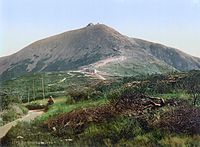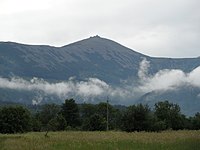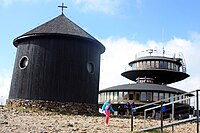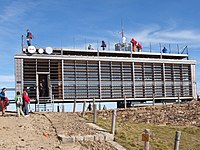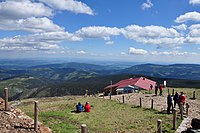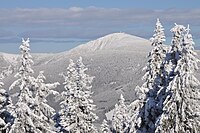geo.wikisort.org - Mountains
Sněžka or Śnieżka (in Czech and Polish respectively; German: Schneekoppe, Slovak: Snežka) is a mountain on the border between the Czech Republic and Poland, the most prominent point of the Silesian Ridge in the Giant Mountains. At 1,603.3 metres (5,260 ft), its summit is the highest point in the Czech Republic, in Lower Silesian Voivodeship, in the Giant Mountains and in the entire Sudetes.
| Sněžka Śnieżka | |
|---|---|
| Snežka, Schneekoppe | |
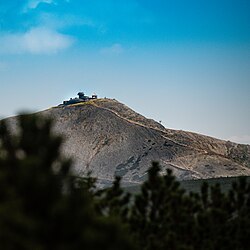 Sněžka from the west. | |
| Highest point | |
| Elevation | 1,603.3 m (5,260 ft)[1] |
| Prominence | 1,197 m (3,927 ft)[1] |
| Isolation | 290 km (180 mi) |
| Listing | Country high point |
| Coordinates | 50°44′10″N 15°44′25″E |
| Geography | |
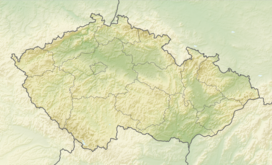 Sněžka Śnieżka Location in the Czech Republic, on the border with Poland  Sněžka Śnieżka Sněžka Śnieżka (Lower Silesian Voivodeship)  Sněžka Śnieżka Sněžka Śnieżka (Poland) | |
| Location | Czech Republic and Poland |
| Parent range | Giant Mountains |
| Climbing | |
| Easiest route | tourist trails, cable car from Pec pod Sněžkou |
History

Sněžka was one of the first European mountains visited by many tourists. This was mainly due to the relatively minor technical difficulties of the ascent and the fact that since the sixteenth century, many resort visitors flocked to the nearby Cieplice Śląskie-Zdrój and the highly visible Sněžka, visually dominant over all Giant Mountains was for them an important attraction.
The first historical account of an ascent to the peak is in 1456, by an unknown Venetian merchant searching for precious stones. The first settlements on the mountain soon appeared, being primarily mining communities, tapping into its deposits of copper, iron and arsenic. The mining shafts, totalling 1.5 kilometres (0.93 mi) in length, remain to this day.
The first recorded German name was Riseberg ("giant mountain", cf. Riesengebirge, "Giant Mountains"), mentioned by Georg Agricola in 1546. Fifteen years later the name Riesenberg appears on Martin Helwig's map of Silesia. The German name later changed to Riesenkoppe ("giant top") and finally to Schneekoppe ("snow top", "snowy head").[2]
In Czech, the mountain was initially called Pahrbek Sněžný ("snow hill"); later Sněžka, with the eventual name Sněžovka, meaning "snowy" or "snow-covered", which was adopted in 1823. An older Polish name for the mountain was Góra Olbrzymia, meaning "giant mountain".[3]
The first building on the mountaintop was the Chapel of Saint Lawrence (Laurentiuskapelle), built c. 1665–1681 by the Silesian noble Schaffgotsch family to mark their dominion, serving also as an inn for a brief period of time. The territory including the mines were the property of the Schaffgotsch family until 1945. The so-called Prussian hut (Preußische Baude) was built on the Silesian (now Polish) side in 1850, followed by the Bohemian hut (Česká bouda) on the Bohemian (now Czech) side in 1868, both built with the purpose of providing lodging. The Prussian hut was rebuilt twice after fires (1857 and 1862), and the (after 1945) "Polish hut" was finally demolished in 1967. The Bohemian hut fell into disrepair after 1990 and was demolished in 2004.
A wooden weather station was built on the mountaintop in c. 1900, being the only weather station in Central Europe remaining intact after World War II. It was demolished in the 1980s.

Today

One side of the mountain is in the Czech Republic; the other belongs to Poland. The area is very popular in summer with tourists from the Czech Republic, Poland, and Germany, who enjoy hiking in the alpine environment unique to this area.
On the Polish side a disc-shaped observatory with a weather station and restaurant was built in 1974, and the St. Lawrence Chapel. On the Czech side are a post office, and a chairlift station, connecting the peak with the town of Pec pod Sněžkou at the base of the mountain.
Although the mountain is the highest natural peak in the Czech Republic, the actual highest point is the top of the television transmitter on Praděd, reaching 1,652 metres (1,491+162 m). If the Polish observatory is taken into account, Sněžka peaks at 1,620 metres.
In 2004 a new post office and observation platform replaced an old post office and the remains of the Bohemian hut, which had been closed since the 1980s.
In March 2009 the Polish observatory suffered serious damage to the upper disc as a result of extreme weather and structural failure. The upper disc's floor broke, though a fast response from the Technical University of Wrocław saved the remaining disc from taking any further damage. The restaurant and meteo offices were reopened soon after the construction team had finished clearing the debris and securing what was left of the observatory. After detailed inspection it was determined that no further damage should occur and the building was restored to its previous state. The upper disc was restored to its 1974 design (with contemporary improvements), skipping certain "improvements" made in 1980s and 1990s which were suspected to contribute to the structural failure of March 2009.
The old chairlift to the top of Sněžka was replaced by a new cable car system. Since February 2014, the four-person cabins in two sections have carried 250 visitors per hour from Pec pod Sněžkou.[4]
There are many marked tourist routes from the Polish side to the summit, mainly from the town of Karpacz. It is possible to take a chairlift from Karpacz to Kopa (1377 m a.s.l.) which significantly shortens the way to the summit.
Śnieżka belongs to the Crown of Europe, Crown of Polish Mountains and Crown of Sudetes.
Climate
Due to high altitude the climate is maritime polar (Köppen: ET) not far from a continental subpolar climate (Dfc).[5] The difference should be at least 6 °C lower on annual average compared to the weather station in the plains.[6][7]
| Climate data for Sněžka[lower-alpha 1] (1991-2020 normals, extremes 1951-present) | |||||||||||||
|---|---|---|---|---|---|---|---|---|---|---|---|---|---|
| Month | Jan | Feb | Mar | Apr | May | Jun | Jul | Aug | Sep | Oct | Nov | Dec | Year |
| Record high °C (°F) | 10.5 (50.9) |
13.5 (56.3) |
12.1 (53.8) |
18.2 (64.8) |
21.2 (70.2) |
22.6 (72.7) |
24.6 (76.3) |
24.3 (75.7) |
21.3 (70.3) |
19.9 (67.8) |
17.1 (62.8) |
12.0 (53.6) |
24.6 (76.3) |
| Mean maximum °C (°F) | 4.4 (39.9) |
4.5 (40.1) |
6.0 (42.8) |
10.9 (51.6) |
15.4 (59.7) |
18.8 (65.8) |
20.2 (68.4) |
20.0 (68.0) |
15.4 (59.7) |
12.8 (55.0) |
9.4 (48.9) |
6.0 (42.8) |
21.8 (71.2) |
| Average high °C (°F) | −3.3 (26.1) |
−3.7 (25.3) |
−1.9 (28.6) |
2.7 (36.9) |
7.4 (45.3) |
10.7 (51.3) |
12.7 (54.9) |
12.8 (55.0) |
8.3 (46.9) |
4.6 (40.3) |
1.0 (33.8) |
−2.2 (28.0) |
4.1 (39.4) |
| Daily mean °C (°F) | −5.9 (21.4) |
−6.2 (20.8) |
−4.3 (24.3) |
0.0 (32.0) |
4.4 (39.9) |
7.7 (45.9) |
9.8 (49.6) |
9.9 (49.8) |
5.8 (42.4) |
2.1 (35.8) |
−1.6 (29.1) |
−4.7 (23.5) |
1.4 (34.5) |
| Average low °C (°F) | −8.3 (17.1) |
−8.5 (16.7) |
−6.5 (20.3) |
−2.2 (28.0) |
2.1 (35.8) |
5.4 (41.7) |
7.5 (45.5) |
7.8 (46.0) |
3.8 (38.8) |
−0.1 (31.8) |
−3.9 (25.0) |
−7.1 (19.2) |
−0.8 (30.6) |
| Mean minimum °C (°F) | −16.7 (1.9) |
−16.5 (2.3) |
−13.5 (7.7) |
−10.1 (13.8) |
−4.7 (23.5) |
−1.0 (30.2) |
1.4 (34.5) |
1.7 (35.1) |
−2.2 (28.0) |
−7.0 (19.4) |
−11.1 (12.0) |
−14.7 (5.5) |
−19.3 (−2.7) |
| Record low °C (°F) | −32.1 (−25.8) |
−33.9 (−29.0) |
−25.5 (−13.9) |
−15.5 (4.1) |
−13.1 (8.4) |
−7.1 (19.2) |
−2.2 (28.0) |
−2.6 (27.3) |
−5.8 (21.6) |
−14.7 (5.5) |
−20.3 (−4.5) |
−24.9 (−12.8) |
−33.9 (−29.0) |
| Average precipitation mm (inches) | 107.3 (4.22) |
88.5 (3.48) |
87.7 (3.45) |
51.1 (2.01) |
77.5 (3.05) |
98.1 (3.86) |
120.6 (4.75) |
95.4 (3.76) |
87.3 (3.44) |
79.9 (3.15) |
83.4 (3.28) |
113.8 (4.48) |
1,090.6 (42.94) |
| Average extreme snow depth cm (inches) | 78.8 (31.0) |
99.7 (39.3) |
109.7 (43.2) |
76.0 (29.9) |
25.8 (10.2) |
0.8 (0.3) |
0.0 (0.0) |
0.0 (0.0) |
1.2 (0.5) |
7.3 (2.9) |
16.9 (6.7) |
43.1 (17.0) |
109.7 (43.2) |
| Average precipitation days (≥ 0.1 mm) | 22.57 | 20.50 | 22.00 | 17.23 | 19.10 | 18.67 | 18.77 | 16.80 | 17.97 | 21.37 | 22.03 | 23.03 | 240.03 |
| Average snowy days (≥ 0 cm) | 31.0 | 28.3 | 31.0 | 28.3 | 10.0 | 0.4 | 0.0 | 0.0 | 1.1 | 8.2 | 18.7 | 29.3 | 186.3 |
| Average relative humidity (%) | 84.5 | 86.1 | 88.1 | 85.7 | 86.8 | 87.6 | 86.6 | 85.8 | 89.9 | 87.6 | 86.5 | 84.6 | 86.6 |
| Average dew point °C (°F) | −9 (16) |
−9 (16) |
−7 (19) |
−2 (28) |
2 (36) |
6 (43) |
8 (46) |
7 (45) |
4 (39) |
−1 (30) |
−4 (25) |
−8 (18) |
−1 (30) |
| Mean monthly sunshine hours | 72.2 | 80.1 | 103.3 | 157.8 | 177.8 | 172.2 | 187.9 | 190.0 | 122.3 | 99.6 | 67.9 | 63.8 | 1,494.8 |
| Source 1: Institute of Meteorology and Water Management[8][9][10][11][12][13][14][15] | |||||||||||||
| Source 2: Meteomodel.pl (records, relative humidity 1991–2020),[16][17][18] Time and Date (dewpoints, 2005-2015)[19] | |||||||||||||
| Climate data for Sněžka (ridge), elevation 1603 m; 1961–1990 | |||||||||||||
|---|---|---|---|---|---|---|---|---|---|---|---|---|---|
| Month | Jan | Feb | Mar | Apr | May | Jun | Jul | Aug | Sep | Oct | Nov | Dec | Year |
| Record high °C (°F) | 9.0 (48.2) |
9.2 (48.6) |
12.0 (53.6) |
18.2 (64.8) |
18.4 (65.1) |
20.5 (68.9) |
23.6 (74.5) |
23.4 (74.1) |
21.1 (70.0) |
18.1 (64.6) |
14.6 (58.3) |
13.2 (55.8) |
23.6 (74.5) |
| Average high °C (°F) | −4.5 (23.9) |
−4.4 (24.1) |
−2.5 (27.5) |
1.2 (34.2) |
6.3 (43.3) |
9.4 (48.9) |
10.9 (51.6) |
11.1 (52.0) |
8.0 (46.4) |
4.9 (40.8) |
−0.4 (31.3) |
−3.1 (26.4) |
3.1 (37.5) |
| Daily mean °C (°F) | −7.0 (19.4) |
−6.8 (19.8) |
−5.0 (23.0) |
−1.4 (29.5) |
3.4 (38.1) |
6.5 (43.7) |
8.0 (46.4) |
8.2 (46.8) |
5.3 (41.5) |
2.3 (36.1) |
−2.8 (27.0) |
−5.6 (21.9) |
0.4 (32.8) |
| Average low °C (°F) | −9.5 (14.9) |
−9.1 (15.6) |
−7.2 (19.0) |
−3.6 (25.5) |
1.2 (34.2) |
4.3 (39.7) |
5.8 (42.4) |
6.1 (43.0) |
3.3 (37.9) |
0.0 (32.0) |
−5.0 (23.0) |
−8.0 (17.6) |
−1.8 (28.7) |
| Record low °C (°F) | −32.1 (−25.8) |
−22.6 (−8.7) |
−25.5 (−13.9) |
−14.8 (5.4) |
−12.0 (10.4) |
−7.1 (19.2) |
−2.2 (28.0) |
−2.6 (27.3) |
−5.3 (22.5) |
−12.0 (10.4) |
−17.4 (0.7) |
−24.9 (−12.8) |
−32.1 (−25.8) |
| Average precipitation mm (inches) | 87 (3.4) |
91 (3.6) |
87 (3.4) |
104 (4.1) |
123 (4.8) |
141 (5.6) |
138 (5.4) |
132 (5.2) |
85 (3.3) |
76 (3.0) |
103 (4.1) |
96 (3.8) |
1,263 (49.7) |
| Average precipitation days (≥ 1.0 mm) | 16.2 | 14.6 | 15.0 | 13.6 | 13.4 | 14.7 | 13.5 | 12.5 | 11.9 | 11.3 | 16.2 | 16.9 | 169.8 |
| Mean monthly sunshine hours | 72.0 | 84.0 | 101.0 | 125.0 | 158.0 | 143.0 | 154.0 | 155.0 | 116.0 | 117.0 | 62.0 | 65.0 | 1,352 |
| Source: NOAA[20] | |||||||||||||
See or edit raw graph data.
Gallery
- Sněžka, a photochrom print from ca. 1900
- Sněžka above the clouds
- Panorama of Sněžka
- St. Lawrence's Chapel built in 1665–1681
- Observatory on the mountain top
- Czech post office building atop Sněžka
- Chairlift station atop Sněžka
- Mountain trail
- View of the mountain in winter
- West view
See also
- Polish–Czech Friendship Trail
- List of mountains in Poland
References
- "Sněžka, Czech Republic/Poland" Peakbagger.com. Retrieved 2012-10-27.
- the highest ridge in the 'Giant Mountains' rises to a height of 1,603.30 metres at the peak of 'Snowy Head', p.39 in Norman Davies, Roger Moorhouse: Microcosm: Portrait of a Central European City, Jonathan Cape, 2002 ISBN 978-0-224-06243-5, 585 pages
- Geographische Namen in den Böhmischen Ländern Archived 14 May 2008 at the Wayback Machine – see entry Sněžka
- New cable car on Sněžka, Giant Mountains, Czech Republic Retrieved 2014-09-14'
- Peterson, Adam (20 September 2016), English: Köppen climate types of the Czech Republic, retrieved 4 February 2019
- Janušková, Miriam (14 September 2016). "Kontinentalita klimatu ve vztahu k radiačním a cirkulačním faktorům" (in Slovak).
{{cite journal}}: Cite journal requires|journal=(help) - Hlavinka, P.; Zalud, Z.; Wilhite, D. A.; Hayes, M. J.; Trnka, M.; Svoboda, M. D.; Dubrovsky, M. (1 April 2009). "Application of relative drought indices in assessing climate-change impacts on drought conditions in Czechia". Theoretical and Applied Climatology. 96 (1–2): 155–171. Bibcode:2009ThApC..96..155D. doi:10.1007/s00704-008-0020-x. ISSN 1434-4483. S2CID 12913442.
- "Średnia dobowa temperatura powietrza". Normy klimatyczne 1991-2020 (in Polish). Institute of Meteorology and Water Management. Archived from the original on 3 December 2021. Retrieved 22 January 2022.
- "Średnia minimalna temperatura powietrza". Normy klimatyczne 1991-2020 (in Polish). Institute of Meteorology and Water Management. Archived from the original on 15 January 2022. Retrieved 22 January 2022.
- "Średnia maksymalna temperatura powietrza". Normy klimatyczne 1991-2020 (in Polish). Institute of Meteorology and Water Management. Archived from the original on 15 January 2022. Retrieved 22 January 2022.
- "Miesięczna suma opadu". Normy klimatyczne 1991-2020 (in Polish). Institute of Meteorology and Water Management. Archived from the original on 9 January 2022. Retrieved 22 January 2022.
- "Liczba dni z opadem >= 0,1 mm". Normy klimatyczne 1991-2020 (in Polish). Institute of Meteorology and Water Management. Archived from the original on 15 January 2022. Retrieved 22 January 2022.
- "Średnia grubość pokrywy śnieżnej". Normy klimatyczne 1991-2020 (in Polish). Institute of Meteorology and Water Management. Archived from the original on 15 January 2022. Retrieved 22 January 2022.
- "Liczba dni z pokrywą śnieżna > 0 cm". Normy klimatyczne 1991-2020 (in Polish). Institute of Meteorology and Water Management. Archived from the original on 15 January 2022. Retrieved 22 January 2022.
- "Średnia suma usłonecznienia (h)". Normy klimatyczne 1991-2020 (in Polish). Institute of Meteorology and Water Management. Archived from the original on 15 January 2022. Retrieved 22 January 2022.
- "ŚNIEŻKA Absolutna temperatura maksymalna" (in Polish). Meteomodel.pl. Retrieved 22 January 2022.
- "ŚNIEŻKA Absolutna temperatura minimalna" (in Polish). Meteomodel.pl. Retrieved 22 January 2022.
- "ŚNIEŻKA Średnia wilgotność" (in Polish). Meteomodel.pl. Retrieved 22 January 2022.
- "Climate & Weather Averages in Śnieżka". Time and Date. Retrieved 24 July 2022.
- "Sněžka (12510) – WMO Weather Station". NOAA. Retrieved 31 December 2018. Archived 27 December 2018, at the Wayback Machine.
Notes
- The weather station is located on a ridge at an altitude of 1,603 m (5,259 ft)
External links
- Sněžka chairlift information – including current status and webcam (in Czech, English, German, and Polish)
- Sněžka
- Sněžka
- Sněžka
- weatherforecast
- WEBCAM (high resolution) on Sněžka (in Czech, English, German, and Polish)
- Photo gallery of Śnieżka (in Polish)
- Śnieżka (1603 m n.p.m.) - Gigantaeus Mons, Riesenberg, Schneekoppe, Sněžka Photo gallery of Śnieżka - na portalu polska-org.pl (in Polish)
- Piotr Krzaczkowski's Photo.net slideshow of Sněžka
- Historical photos of Schneekoppe (1890–1900)
- Historical travel report (1800) by John Quincy Adams
- Historical map of Bohemia with Schneekoppe (1882)
- Historical map of Silesia with Schneekoppe (1882)
- Virtual show
- Śnieżka – Webcam from Karpacz
На других языках
[de] Schneekoppe
Die Schneekoppe (tschechisch Sněžka, polnisch Śnieżka, auch Riesenkoppe oder nur Koppe genannt) ist mit 1603,2 m n.m.[1] die höchste Erhebung des Riesengebirges. Sie ist der höchste Berg der Sudeten, der Mitteleuropäischen Mittelgebirgsschwelle und Tschechiens. Über ihren Gipfel verläuft die Staatsgrenze zwischen Polen und Tschechien. Vor 1945 war die Schneekoppe der höchste Berg Preußens und der deutschen Mittelgebirge.- [en] Sněžka
[es] Sněžka
Sněžka ( pron. en checo (?·i)) (en polaco, Śnieżka) es el punto más elevado de las montañas de los Gigantes, que es a su vez parte de la cordillera de los Sudetes. Con 1.603 metros sobre el nivel del mar, es la cima más alta de la República Checa, y se encuentra dividida entre el territorio de ese país y su vecina septentrional, Polonia (voivodato de Baja Silesia).[fr] Sniejka
Sniejka (« la neigeuse », en tchèque : Sněžka ; en polonais : Śnieżka ; en allemand : Schneekoppe) est la plus haute montagne des monts des Géants. Elle est traversée en son sommet par la frontière entre la Pologne et la Tchéquie. On peut y accéder par un télésiège depuis la ville tchèque de Pec pod Sněžkou. Le point culminant se situe à 1 602 ou 1 603 mètres d'altitude ; c'est aussi le point culminant de la Tchéquie. Le sommet a une superficie plane importante, de plus de 120 000 mètres carrés[réf. nécessaire], ce qui a permis d'y construire plusieurs bâtiments. La température annuelle moyenne y est de 0,2 °C[3]. Sniejka est le point de départ ou le but de nombreux chemins de randonnée pédestre (dont le chemin de l'Amitié tchéco-polonaise), cyclistes et de ski de fond[3].[it] Sněžka
Lo Sněžka (in ceco, Śnieżka in polacco, Schneekoppe in tedesco - 1.603 m s.l.m.) è la montagna più alta dei Monti dei Giganti, nel gruppo montuoso dei Sudeti Occidentali che fa parte della catena dei Sudeti.[ru] Снежка
Сне́жка[2] (чеш. Sněžka, польск. Śnieżka, нем. Schneekoppe) — гора в массиве Крконоше, на границе Польши и Чехии. Высота вершины — 1603 м, это самая высокая точка Крконош[3], Судет[4] и Чехии[5] Северный склон находится в Польше, южный — в Чехии, по вершине проходит граница между странами. Гора сложена сланцами. Склоны покрыты лесами, горными лугами и каменными россыпями. Граница леса находится на высоте 1250-1350м[6].Другой контент может иметь иную лицензию. Перед использованием материалов сайта WikiSort.org внимательно изучите правила лицензирования конкретных элементов наполнения сайта.
WikiSort.org - проект по пересортировке и дополнению контента Википедии
